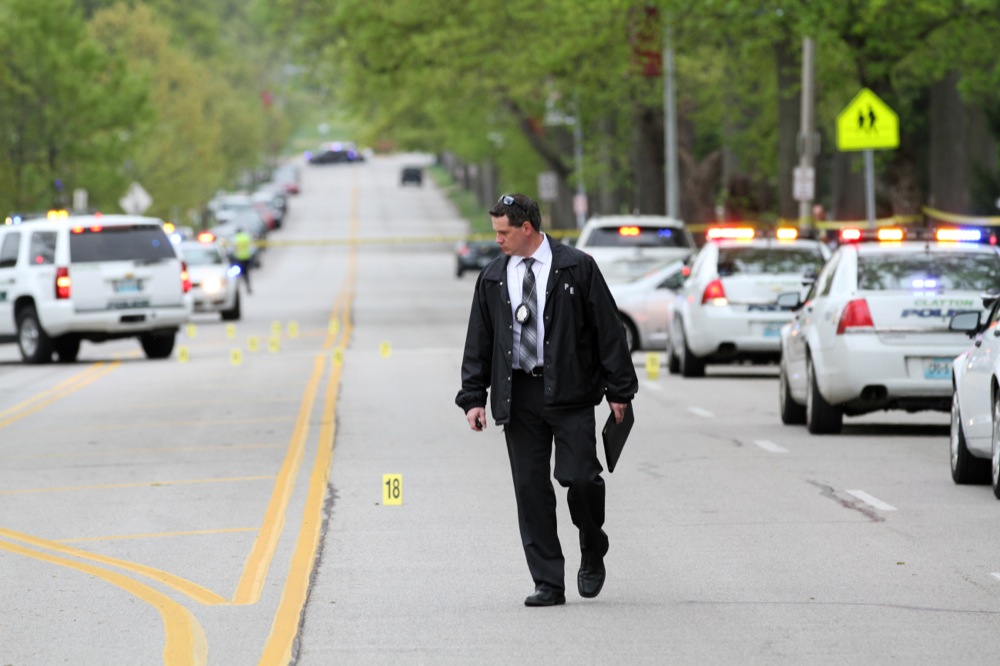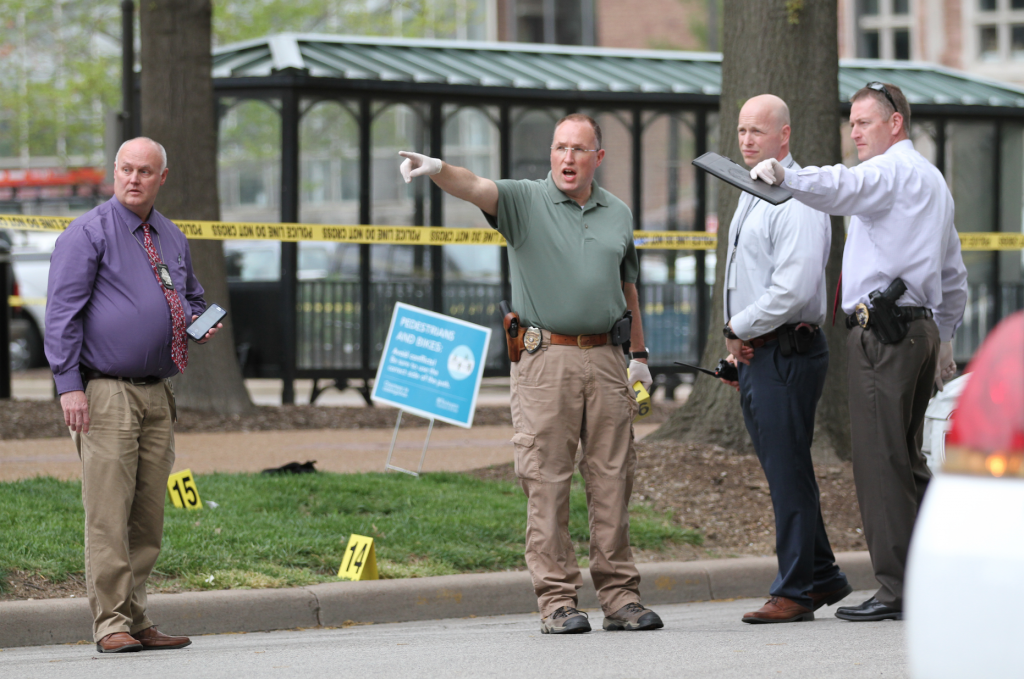Administration | News
WUPD, WU admin reevaluate emergency preparedness a year after Forsyth shooting
Washington University administrators discussed the University’s preparedness for active shooter situations on the Danforth Campus as the one-year anniversary of the April 20 shooting of a Bon Appetit employee approaches.
Last April, the Washington University Police Department responded to reports of shots fired near 6440 Forsyth Blvd., just outside of Mallinckrodt Center. A Bon Appetit employee received nonlife threatening injuries and was transported to the hospital for medical care after being shot by an unknown assailant. Less than ten minutes after the shooting took place, students, faculty and staff received alerts via text messages, phone calls and push notifications on the WUSTL app.

An officer surveys Forsyth Boulevard after the shooting on April 20. The Danforth Campus was put on lockdown from approximately 1:30 p.m. to 2:46 p.m. following the shooting.
Investigations were led by the Clayton Police Department and supported by WUPD as the incident occurred within Clayton’s jurisdiction. A GoFundMe page, created by former Washington University undergraduate Darius Calliet, was shared over 2,500 times on social media and raised $8,490 for the shooting victim.
WUPD Chief Mark Glenn believes that the department responded to the shooting appropriately and in a manner similar to that of the University’s peer institutions.
“We felt after we reviewed it, our response was within our protocol that we established. On the back end, we found some issues that we wanted to improve, but from the police end, we learned to be more direct in the application of our protocols that we had. I think we’re within the recommended response protocols nationwide when we talk to our peer organizations police-wise,” Glenn said.
According to Glenn, WUPD dispatchers are often overwhelmed by the sheer volume of calls they receive daily. The department is making efforts to streamline the process of managing and responding to various calls. Despite the multimode WUSTL alert system, coverage from the incident conveyed an atmosphere of confusion as “employees and students searched for safe spaces and professors determined whether to continue regular instruction in their classes.”
Washington University’s Safety and Security Guide for the 2016-17 academic year recommends that students “Run, Hide, [and] Fight” if they are involved in a situation where a shooter has entered the area and began firing. The protocol does not include clear directions for individuals who are not in close proximity to a shooter. Glenn states that the purpose of the “Run, Hide, Fight” program is to empower students to make the best decision for themselves with whatever information is available, rather than becoming reliant upon potentially outdated information. Initial alerts are campus-specific and are intended to prompt individuals to be more aware of their surroundings in order to build knowledge amongst students, faculty and staff on how to react during active shooter situations.
“Part of the problem—and we are not the only ones that struggle with this at times—is making sure that we get out accurate information in a timely manner. Unfortunately, there gets to be the expectation that we’re going to send out a mass notification and tell everybody what the proper thing to do at that time [is]. To be honest, it’s impossible for us to do it because these situations are so fluid and they’re moving,” Glenn said.
Additional concerns raised by students, including junior Thomas Van Horn in a Student Life op-ed, addressed faculty’s response to the shooting last spring. While some professors continued to lecture, others dismissed class or barricaded entrances to their classrooms. While all University employees are not required to complete training on proper active shooting procedures, the Emergency Management Department offers resources including faculty workgroups to inform educators about emergency protocols.
According to Director of Emergency Management and Business Continuity Ty Davisson, a quick guide to emergencies has been placed in most shared classrooms on campus to provide faculty members with a refresher on standard protocols. Additionally, the Emergency Management Department has been given the opportunity to become involved in new faculty orientations and discuss practical guidelines during routine times, such as staff meetings.
While Washington University community members are automatically notified, the same doesn’t apply to employees of the University’s campus service providers—most notably TopCare and Bon Appetit. Because these individuals are not considered direct University employees, they must download the WUSTL app onto their smartphones in order to receive push notifications in the case of an emergency. According to Davisson, the University’s Emergency Management Department has partnered with the Resource Management unit to ensure that vendors include the aforementioned mechanisms in their contracts with the University.

Police work in the marked-off area following April 20’s shooting on Forsyth Boulevard. The shooting led to a Danforth Campus lockdown.
“Because they are not our employees we cannot force them to download the app. And because they may be in a job where they don’t have access to a smartphone or the app, that rests on the baseline service providers,” Davisson said. “We’ve worked independently with each one of those and established a plan for how we’re going to communicate. They have committed, as one of our service vendors, that their employees have the app that they can receive it in real-time or they have mechanisms in place so they can quickly reach out to their own employees that do not have access to the apps.”
An area addressed following last year’s shooting is access to campus buildings for individuals within different academic divisions. While most buildings are unlocked during normal school hours, a lockdown during nonstandard hours would have rendered students and faculty unable to access buildings that were not associated with the school in which they are currently enrolled. Davisson explained that the issue was resolved by collaborating with the provost’s office.
“We were able to work through our access control groups through the Provost’s office to ensure that during a lockdown in a similar manner that students would be able to access locations. Even if they were not an engineering student, for example, they would still be able to swipe their card and get into the exterior door of that facility if they needed to in order to get to a location that they could adequately shelter in place,” Davisson said.
John Ursch, senior director of public safety and campus services at the School of Medicine, noted the value in aligning public safety protocols across the Danforth and Medical Campuses, as well as the importance of the WUSTL app in remaining aware of emergency situations on both campuses.
“[There are] certain things now that divide the campuses but the student piece is universal. It goes out to all students. The biggest one here is—and it’s something we have to keep meeting on—the app is the great equalizer,” Ursch said. “As time goes on and each new class comes in, we really need to make sure that people are dropping the [WUSTL] app onto their phones so that they’re getting these push notifications. That way, it doesn’t matter what your status is or which campus you’re on, you’re always going to get it through the app.”
